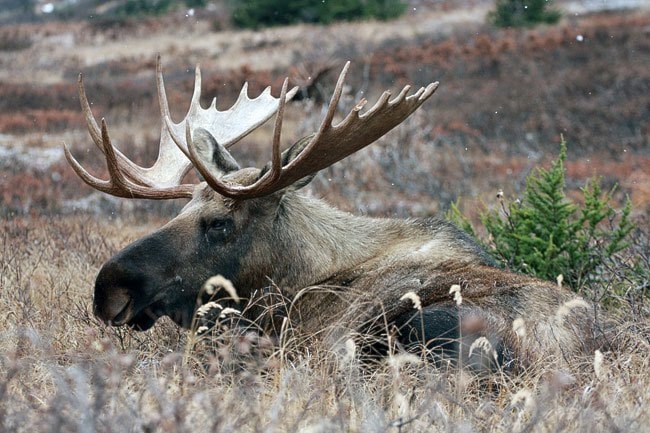The Kluane moose population is in serious trouble, and the local First Nation may have to reduce its annual moose harvest by up to 60 per cent.
Parks Canada has been studying moose in the Upper Duke River area of Kluane National Park for 30 years. With the population steadily declining for the past 20 years, something had to be done, explained Yukon regional biologist Shawn Taylor.
Environment Yukon, Parks Canada and the Kluane First Nation teamed up to study the problem in greater detail in 2011.
“It was the first time that area had been comprehensively surveyed. We had nothing to compare it to, so what we did was look at the density from Duke to Donjek River and Donjek River to White River,” Taylor explained.
They found that moose density in the study area is about 111 per 1,000 square kilometres. The Yukon average is 157.
Taylor is part of a steering committee that includes the First Nation and is looking at ways to reduce the hunting pressures on moose in the area. He said most of the pressure on the population is the result of too much hunting.
They also found that moose harvests over the last 10 years have been higher than the Yukon’s moose management guidelines. About nine per cent of the population is killed each year. The guidelines call for a harvest of between two and five per cent.
That means the Kluane First Nation has to kill fewer moose, between 10 and 22 fewer. That will likely prove a significant challenge, since the vast majority of the moose killed are taken for subsistence purposes. Only seven of last year’s 32 were shot by licensed hunters.
“It’s comparable to a two-thirds pay cut,” Taylor said.
The First Nation held a community meeting on Tuesday to talk about how they will address the problem.
Kluane Chief Math'ieya Alatini said that about 60 people came out to the meeting, and all were supportive of doing something to reduce the number of animals killed.
She said there are two options the community could choose: a moderate reduction in hunting that focuses on only killing bull moose, allowing the cows to continue breeding, or a high reduction that would mean only harvesting 10 animals per year instead of 32.
“When people saw that and were listening to that, they were asked to make selection. It was a mix between the two. Most favoured moderate action, but people are willing to make some sacrifices. It was nice to see the community come out and listen to the information and be willing to make some action to stabilize the moose population,” said Alatini.
As well as hunting less moose, other options include moving hunting areas to ease pressure on the Duke-Kluane moose management area and killing more moose predators like wolves and bears.
“For the First Nation, we’ve been doing a trappers’ incentive program. We offer incentives for trappers to go out on their trap lines and harvest predators. We offer additional amounts for pelts, depending on whether it’s a wolf. Bears are also a big one,” Alatini said.
The community is also looking at having designated hunters do the harvesting, and then distributing the meat fairly throughout the community and to elders.
“You’d have a more equal distribution of meat, instead of having people have one or two freezers full, and you’re reducing waste with that as well,” Alatini said.
“Another one is trying to find alternative sources of meat. So that would mean looking at more bison hunting and distributing that to elders in the community,” Taylor said.
Taylor said the community has also committed to helping record and track the moose population in the future, so all three governments have a better understanding of exactly where the population is at.
The First Nation will also hold a community gathering every May to make plans for the hunt later in the summer.
“We did a show of hands in the room, and people were very supportive of having a gathering similar to what the Northern Tutchone have, and sharing where they are going to focus their hunting and having that action plan,” Alatini said.
With the range of management options put forward at the meeting, both Alatini and Taylor were confident that a ban on moose hunting in the area won’t be necessary. The majority of moose hunting happens in late summer and early autumn.
Contact Jesse Winter at
jessew@yukon-news.com
